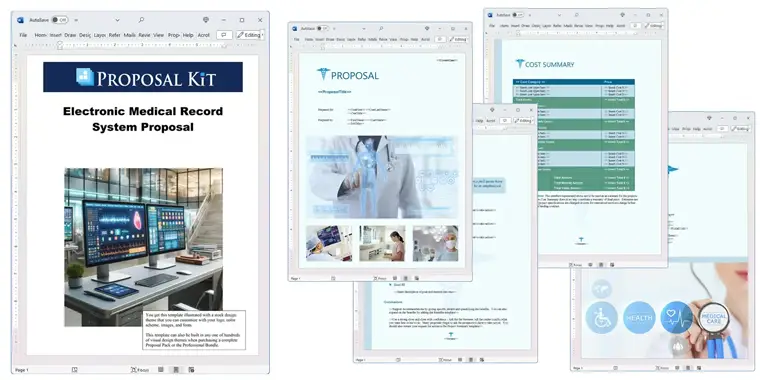How to write your Electronic Medical Record System Proposal
We include this 22 page layout with every Proposal Pack. If you want this template to have a different visual design theme than the one illustrated here, purchase any Proposal Pack design and create this template using the purchased design theme. This template is included in every Proposal Pack. If you get a Proposal Pack or the Professional Bundle, you can also make any variation of this template with different chapters to suit your needs.
We typically include more chapters in the templates than most people will need to give everyone more variety in the chapters they may need. You can trim down a long template by removing pages you do not need or combining multiple chapter topics into one page.
 DOWNLOADABLE, ONE-TIME COST, NO SUBSCRIPTION FEES
DOWNLOADABLE, ONE-TIME COST, NO SUBSCRIPTION FEES![]() View Electronic Medical Record System Sample Proposal
View Electronic Medical Record System Sample Proposal
This sample proposal is based on the same layout as this template and is included in every Proposal Pack. The visual design of the templates will match whichever Proposal Pack design you purchase. To get this template in a different design theme than shown in the sample, purchase any other Proposal Pack design theme and this template will be included.
You can create an editable Word version of this sample in any design theme of your choice including branded to your logo.
 If you need this template on DVD media order from our Amazon shop.
If you need this template on DVD media order from our Amazon shop.
You can also create countless variations of this document to suit your needs using the included library of 2200+ chapters if ordering a Proposal Pack or Pro Bundle.
 What Our Clients Say
What Our Clients SayFirst time user. Found it very convenient. Saves me a lot of time. Thanks."
Phinnacle Wealth Managers Pvt Ltd
Related Article
Related Video
Related Templates
- Electronic Records Management Proposal
- Records Management Survey Analysis
- Records Management Analysis Proposal
- Medical Billing Services Proposal
- Medical Practice Startup Business Plan
- ERP (Enterprise Resource Planning) System Proposal
- Healthcare Consultant Project Proposal
- Pharmacy Startup Business Plan Funding Proposal
- Medical Support Project RFP Response Proposal
- Healthcare Outsourced Services Provider Proposal
- IT Disaster Recovery Services Proposal
- Process Improvement Proposal
What's the Best Way to Write Your Electronic Medical Record System Proposal?
The prospect can seem overwhelming when tasked with upgrading an electronic medical record system (EMR), especially without prior experience. A proven way to navigate this is using the Proposal Kit template and software package. This robust tool simplifies the process by providing structured templates and a comprehensive line item quoting database, which helps create detailed cost summaries, estimates, and budgets. For those unfamiliar with writing proposals, Proposal Kit is a straightforward solution that transforms a complex task into a manageable one.
Are you looking to write a proposal for an electronic medical record system upgrade or a related project?
What Types of Projects Are Electronic Medical Record System Proposals Written For?
Upgrading an electronic medical record system encompasses a variety of projects. Here are ten examples where an electronic medical record system proposal might be necessary:
- Integration of EMR with other hospital management systems
- Migration from paper-based records to a fully digital system
- Updating existing EMR software to enhance data security
- Implementing a new EMR system in a newly opened facility
- Adding patient portal capabilities to existing EMR systems
- Upgrading data storage solutions to support larger EMR systems
- Enhancing EMR systems for better compliance with health regulations
- Integrating advanced data analytics features into EMR systems
- Deploying mobile access to EMR for healthcare professionals
- Implementing backup solutions for EMR to ensure data integrity
Chapters this template is built with
There are countless ways you can structure your proposal using the Proposal Kit. This template uses the following chapters. However, you can customize this layout using the Proposal Kit's Wizard software and template library.
These chapters, written with the help of the Proposal Kit, ensure that every aspect of your electronic medical record system proposal is detailed, professional, and persuasive, tailored to meet the unique needs of your healthcare facility.
Each chapter template from the Proposal Kit helps you comprehensively address the specifics of your EMR system upgrade proposal. These templates are just a small selection of the thousands available in the Proposal Kit library, which can be customized to cover all aspects of your proposal.
Cover Letter
The cover letter is at the forefront of your proposal, setting a professional tone and underscoring the critical nature of the EMR upgrade. It should articulate your dedication to delivering a seamless and efficient solution tailored specifically to the healthcare facility's needs. Highlight your understanding of the challenges associated with outdated systems and your commitment to addressing these with innovative solutions.
Executive Summary
This section should capture the essence of the proposal by briefly summarizing the key points. Outline the main upgrades proposed and the rationale behind each, and succinctly argue why your solution outmatches any others on the market. It's essential to make clear the overarching benefits: cost efficiency, improved security, and compliance with the latest healthcare regulations.
Needs Assessment
Perform a thorough assessment of the current EMR system to determine its functionality gaps and limitations. This evaluation should detail how the existing system fails to meet current demands and the potential risks, such as data breaches or compliance penalties. Highlight the specific needs for upgrading or overhauling the system to underscore the project's urgency.
Challenges
Identify the potential challenges that could arise while implementing the new EMR system. This may include technical issues, like integrating new software with existing hardware, operational challenges, such as training staff on new protocols, or budgetary constraints. Discussing these challenges upfront prepares stakeholders for realistic situations and demonstrates your proactive approach to problem-solving.
Benefits
The benefits section should clearly outline the advantages of the EMR system upgrade. Focus on how the new system will improve patient care by enabling quicker access to medical records, enhancing data security with advanced protection measures, ensuring compliance with health regulations, avoiding penalties, and enhancing the facility's reputation.
Project Deliverables
Define the EMR upgrade project's goals and deliverables. List deliverables such as new software installations, staff training sessions, data migration, and system testing. This section should clarify the project's scope and set clear expectations for its completion.
Delivery Date
Establish a timeline with specific deadlines for each phase of the EMR system upgrade. This timeline should be realistic, allowing for adequate time for each task, including unforeseen delays, and should ensure that the project keeps pace to meet critical healthcare operational needs.
Records Access Security Plan
Propose a comprehensive security plan that outlines the measures to protect patient data in the upgraded EMR system. Discuss encryption, access controls, audit trails, and other security protocols to safeguard information against unauthorized access and data breaches.
Conversion Plan
Detail the process for transferring existing records into the new system, focusing on maintaining data integrity and minimizing downtime. Describe how data will be validated and cleaned before migration to ensure accuracy and completeness.
Development
Discuss any necessary software development or customization required to tailor the EMR system to the specific needs of the healthcare facility. This could involve creating custom modules for unique medical specialties or integrating new patient engagement features.
Content Management
Explain how the upgraded EMR system will handle medical records management, including data entry processes, how records will be accessed, and long-term archiving procedures. This should address concerns about how data will be handled securely and efficiently.
Coordination
Detail the coordination efforts required among various departments to ensure a smooth transition to the new EMR system. This includes collaboration between IT, clinical staff, and administration to align all parties with the project objectives and timelines.
System Integration
Describe the integration process of the new EMR system with other existing hospital management systems. This should cover technical details on data interoperability, user interface compatibility, and support systems.
Hardware and Software
List the hardware and software specifications required to support the new EMR system. This should include servers, workstations, portable devices for mobile access, and any specific software requirements or licensing needed.
Legacy Systems
Discuss the plan for phasing out or integrating legacy systems with the new EMR setup. This should address data migration, decommissioning old systems, and managing overlap during transition.
Budget
Provide a detailed budget, including all financial aspects of the EMR system upgrade. Use Proposal Kit's tools to itemize software purchases, hardware installations, staff training, and system maintenance costs.
Cost Savings
Project the long-term cost savings the new EMR system will offer. Highlight reductions in manual record-keeping, decreased likelihood of errors, and potential savings from enhanced operational efficiencies.
Return on Investment
Analyze the financial and operational return on investment for the EMR system upgrade. Illustrate how future savings and increased efficiency will offset the initial costs, providing a clear timeline for when benefits will outweigh expenses.
Recommendations
Offer well-founded recommendations based on your analysis and the needs assessment. Guide decision-makers toward the most effective and efficient EMR system solutions, ensuring that the proposed upgrades align with the facility's long-term goals.
Use cases for this template
Mia's Medical Milestone
Mia, the owner of a health tech startup, recognized the potential for growth by upgrading small clinics to more advanced EMR systems. She wrote a comprehensive proposal using the Proposal Kit to secure funding and partnership from a more prominent healthcare provider.
Her proposal detailed how the EMR upgrade would enhance operational efficiency and patient data security. The straightforward, compelling narrative built around data integrity and compliance with health regulations, realistic budget estimates, and a robust security plan helped Mia win the contract. The upgrade has since significantly reduced administrative errors and improved patient satisfaction for the clinics involved.
Tom's Timely Transformation
Tom, a project manager at a mid-sized healthcare facility, was tasked with updating their outdated EMR system within a tight deadline imposed by pending healthcare regulations. Leveraging the Proposal Kit, Tom efficiently structured his proposal, outlining the critical needs and the solutions his team could offer.
By using the software's tools to detail each stage of the development process and integrating AI-assisted writing tools for creating precise content, he was able to meet the project's tight deadlines. His proposal was submitted on time and praised for its clarity and thoroughness, leading to swift approval and implementation of the upgrade, thus ensuring compliance and enhancing system reliability.
Nina's Non-Profit Network
Nina, a non-profit health network director, needed to draft an RFP to upgrade the EMR systems across several community health centers. Using the Proposal Kit, Nina created a detailed and organized RFP outlining the community centers' specific needs, including system integration, data security, and user-friendly interfaces suitable for multiple health service providers.
The RFP's comprehensiveness and clarity facilitated precise and competitive bids from technology providers. The successful upgrade improved the network's service delivery, patient data handling, and compliance with new health regulations, which enhanced its funding eligibility and community trust.
Conclusions and Recommendations
Proposal Kit is an invaluable resource for anyone needing to create a professional and effective electronic medical record system proposal. The structured templates and tools provided help simplify the complex process of proposal writing, ensuring that all aspects of the project are covered comprehensively.
Also Known As
This template may also be referred to in different ways or be used in more specialized situations, such as:
- Digital Health Record System Initiative
- Electronic Patient Record Implementation Plan
- Healthcare Information Technology Upgrade Proposal
- Medical Digital Documentation Enhancement Plan
- E-Health Record Transformation Proposal
- Electronic Clinical Record Deployment Strategy
- Health Informatics Modernization Proposal
- Digital Patient Chart System Project
- Integrated Electronic Medical Documentation Proposal
- Smart Health Record System Implementation Plan
Abstract
 When healthcare providers consider upgrading their electronic medical record (EMR) systems, the task may seem daunting, yet it offers substantial benefits to primary care providers and other healthcare professionals. Achieving major breakthroughs with electronic records requires only modest investments compared to traditional paper records, leading to improved quality of medical care and increased ability to handle patients' information efficiently. The federal government has encouraged the adoption of EHR systems, emphasizing the importance of better care and improved patient safety through proper implementation. Initiatives led by collaborative groups and primary care societies have been instrumental in educating healthcare members about the value of EMR systems, which are linked to enhanced decision support and confidentiality of patient information.
When healthcare providers consider upgrading their electronic medical record (EMR) systems, the task may seem daunting, yet it offers substantial benefits to primary care providers and other healthcare professionals. Achieving major breakthroughs with electronic records requires only modest investments compared to traditional paper records, leading to improved quality of medical care and increased ability to handle patients' information efficiently. The federal government has encouraged the adoption of EHR systems, emphasizing the importance of better care and improved patient safety through proper implementation. Initiatives led by collaborative groups and primary care societies have been instrumental in educating healthcare members about the value of EMR systems, which are linked to enhanced decision support and confidentiality of patient information.
In the long run, implementing EMR systems provides a robust platform that integrates primary care informatics with national alliance-driven policies. By accelerating the utilization of electronic records, healthcare facilities can adopt practical strategies, supported by investments in necessary infrastructure, to achieve routine use and complete integration of EMR systems. Physicians and specialists benefit from increased ability to access necessary medical information, enhancing treatment decisions and overall medical care. As the internet and digital technologies continue to evolve, the transition from paper records to EMR systems transitions healthcare into a new era, ensuring that clinicians, nurses, and administrative staff are equipped to deliver excellent primary care and optimal patient outcomes.
Overall, the adoption of EMR systems, compared to legacy systems, represents a significant step forward for healthcare providers. With the support of the federal government and primary care societies, the importance of implementing specific policies and conducting education is clear. The substantial benefits realizable through modest investments in EMR systems include enhanced patient safety, data integrity, and compliance with health regulations. By transforming patient information management and facilitating seamless integration across departments, healthcare organizations can ensure better care, reduced errors, and a strong return on investment, ultimately contributing to the country's healthcare improvement goals.
 Upgrading electronic medical record (EMR) systems offers healthcare providers an opportunity to enhance overall medical care by achieving major breakthroughs in managing patient information. With only modest investments, the transition from paper records to electronic systems is gaining momentum, driven by primary care informatics and collaborative groups sponsored by national alliances. These efforts are crucial in educating primary care providers and clinicians about the benefits realizable from robust EMR systems, including improved quality of care, better decision support, and enhanced confidentiality of medical information.
Upgrading electronic medical record (EMR) systems offers healthcare providers an opportunity to enhance overall medical care by achieving major breakthroughs in managing patient information. With only modest investments, the transition from paper records to electronic systems is gaining momentum, driven by primary care informatics and collaborative groups sponsored by national alliances. These efforts are crucial in educating primary care providers and clinicians about the benefits realizable from robust EMR systems, including improved quality of care, better decision support, and enhanced confidentiality of medical information.
The adoption of EHR systems is further encouraged by the federal government's emphasis on implementing specific policies that ensure compliance with the Health Insurance Portability and Accountability Act (HIPAA) and other regulations. Healthcare facilities can realize substantial benefits by transitioning to digital systems, which boost efficiency, reduce errors, and enable the routine use of patient data. The increased ability to access complete medical records enhances physicians' and nurses' capacity to deliver timely and effective treatments, improving both safety and patient satisfaction.
Recent developments in technology have facilitated the integration of EMR systems with other hospital management systems, allowing for seamless data interoperability and streamlined billing processes. By implementing EMRs, healthcare organizations can develop strategies for enhanced data security, including encryption and audit trails, to protect patient information from unauthorized access. The infrastructure required for such systems includes modern servers, mobile devices for prescriptions, and user-friendly interfaces that cater to both healthcare professionals and patients.
 In the long run, the move toward digital health record system initiatives aligns with the goals of primary care societies to foster excellent primary care. By distributing practical tools and engaging in research, healthcare entities can support the adoption of EMR systems, ensuring that the necessary information is readily available for informed decision-making. As healthcare networks, including non-profit organizations, embrace this transformation, they demonstrate the value of linked systems in managing depression, drug prescriptions, and other complex health conditions.
In the long run, the move toward digital health record system initiatives aligns with the goals of primary care societies to foster excellent primary care. By distributing practical tools and engaging in research, healthcare entities can support the adoption of EMR systems, ensuring that the necessary information is readily available for informed decision-making. As healthcare networks, including non-profit organizations, embrace this transformation, they demonstrate the value of linked systems in managing depression, drug prescriptions, and other complex health conditions.
Ultimately, the shift from legacy systems to integrated electronic medical documentation proposals reflects the growing importance of modernizing healthcare delivery. With the right investments in technology and education, healthcare providers can improve medicine practices, enhance the patient experience, and realize cost savings that contribute to the sustainability of healthcare services across the country.
Frequently Asked Questions
What should an electronic medical record system proposal include?
An electronic medical record (EMR) system proposal should include a comprehensive overview of the project's purpose, objectives, and benefits. Key elements include an executive summary, a detailed description of the current system's limitations, scope of work, technical requirements, budget and cost analysis, implementation timeline, risk management, training plans, and expected outcomes. Additionally, stakeholder analysis and data security measures should be addressed to ensure the proposal meets regulatory standards and organizational needs.
How do I justify the cost of implementing an EMR system?
Justifying the cost of an EMR system involves highlighting both the direct and indirect benefits. Direct benefits include improved efficiency, reduced paperwork, and better data management, which can lead to long-term cost savings. Indirect benefits include enhanced patient care, improved medical record accuracy, and better compliance with legal and regulatory requirements. Providing case studies or data from similar organizations that have successfully implemented EMR systems can strengthen your justification.
What challenges should be addressed in an EMR system proposal?
Common challenges that need to be addressed in an EMR system proposal include data migration, user training, system integration, and cybersecurity concerns. Additionally, staff resistance to change, potential downtime during implementation, and the need for ongoing technical support must be considered. Identifying these challenges upfront and presenting viable solutions or mitigation strategies demonstrates thorough planning and helps gain stakeholder confidence.
How can I ensure stakeholder buy-in for the EMR system proposal?
It is crucial to involve key stakeholders early in the planning process to ensure stakeholder buy-in. Conducting needs assessments, gathering input through surveys or meetings, and communicating the benefits and impact of the EMR system can foster support. Tailoring the proposal to address stakeholders' specific concerns and priorities, such as healthcare providers, administrative staff, and IT personnel, can also help gain their buy-in.
What are the best practices for writing an EMR system proposal?
Best practices for writing an effective EMR system proposal include clarity, conciseness, and organization. Use clear, jargon-free language to explain technical aspects and ensure the proposal is logically structured with headings and subheadings for easy navigation. Include data and evidence to support your claims and ensure all sections are aligned with the project's overall objectives. Proofreading the document for errors and seeking feedback from colleagues can further enhance the quality of the proposal.
15% Off Discount
![]() Add To Cart This Word Template Only
Add To Cart This Word Template Only
 Add To Cart Proposal Pack Medical #7
Add To Cart Proposal Pack Medical #7
 Add To Cart Proposal Kit Professional Bundle
Add To Cart Proposal Kit Professional Bundle
 4.7 stars, based on 846 reviews
4.7 stars, based on 846 reviewsProposal Kit chapters used in this template
Cover Letter, Title Page, Table of Contents, Executive Summary, Needs Assessment, Challenges, Benefits, Conversion Plan, Development, Coordination, Content Management, Records Access Security Plan, Hardware and Software, System Integration, Legacy Systems, Project Deliverables, Delivery Date, Budget, Cost Savings, Return on Investment, Recommendations, Back Page
Included Calculator Spreadheets
These Excel calculator spreadsheets are included with this template. If you purchase a Proposal Pack or the Professional Bundle, these proposal pages are generated using an automated line-item database in the included Wizard software. The calculator spreadsheets are intended for use when purchasing only the static Word template.
You use this proposal for
- General business proposal
- Technical proposal
- Project pitch proposal
- Internal company proposal
- Medical, healthcare, wellness proposal
- IT, software, hardware proposal
How to create this template with Proposal Pack Wizard
You can create this document using any of the logo-designed Proposal Packs. Pick any Proposal Pack with a logo design theme you like best; they will all work equally well. The Proposal Pack for Any Business is the pack with no extra added logos or colors - designed to be used plain or for you to customize with your logos and graphics.
The Proposal Pack design theme you purchase will determine the visual look of this template. The screenshot above only shows the plain generic design theme. Names and stories in examples are fictional; however, the templates are from real client use cases.
We include a library of chapters to be assembled based on your needs. All proposals are different and have different needs and goals. We designed Proposal Pack so you can customize the documents to suit your needs.
You will best create this document using the Proposal Pack Wizard - Expert Edition software to select this template and build it in the Proposal Pack logo design theme of your choice along with any desired customizations (such as adding additional chapters, removing unneeded chapters, changing the order of chapters, and importing your company logo). This template outlines a proposal for the described situation. Each user is responsible for typing in the actual content of the provided pages with their information to complete the proposal. Suggestions in the abstract may include features in higher-end packages and are facilitated by the selection of chapter templates to support the narrative of each proposal, which help guide the user in filling in the details.
You create this template using the Wizard software with an entire Proposal Pack library and software. We include the Expert Edition of the software in the Proposal Kit Professional bundle. Microsoft Word for Windows is required to use the customizing software. You can also edit Word document templates in other office software such as Word for Mac. We will assist Mac users in assembling complex templates for their first project if they do not have the required platform to run the Wizard software.
You only get the single assembled Word document if purchased as a stand-alone template. The individual template products include no other templates, samples, or software.
How to Build Templates Featured on Proposal Kit Website
Many people find the Proposal Kit website after searching for a specific proposal. Once you've purchased and installed the software, how do you build that template you found in the first place? This video shows you how to build any proposal you see on the Proposal Kit website.
Key Takeaways
- The Electronic Medical Record System Proposal is available as a ready-to-edit template.
- You can create unlimited custom variations of this template using a Proposal Pack or the Professional Bundle.
- Using a Proposal Pack or Professional Bundle, you can automate quotes and other financial pages with a line-item database.
- There are no ongoing subscription fees. You get lifetime unlimited use.
- We made Proposal Kit for freelancers, small businesses, and non-profits.
- Proposal Kit product content (templates, samples, software) is 100% written by humans.
 Ian Lauder has been helping businesses write their proposals and contracts for two decades. Ian is the owner and founder of Proposal Kit, one of the original sources of business proposal and contract software products started in 1997.
Ian Lauder has been helping businesses write their proposals and contracts for two decades. Ian is the owner and founder of Proposal Kit, one of the original sources of business proposal and contract software products started in 1997.By Ian Lauder
 Published by Proposal Kit, Inc.
Published by Proposal Kit, Inc.


 Cart
Cart


 Get 15% off ordering today:
Get 15% off ordering today: 

 Facebook
Facebook YouTube
YouTube X
X Search Site
Search Site